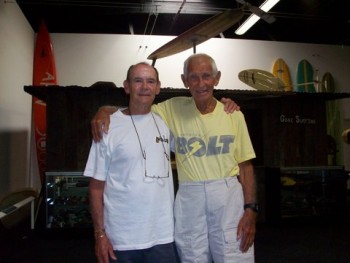A Paipo
Interview with Derek Jardine
August 7, 2012 - Durban, South Africa.
E-mail interview by Bob Green.
Assistance with this interview was provided by Bev Angus, Harry Bold,
Geoff Cater, Allan Jackson,
Dick Metz, Glen Thompson, Johnny
Vassilaros, Michael Walker and John Whittle.
Derek rode a homemade ply paipo in Durban in the 1940s.
He and his
friends cut down longer bellyboards that were sold to tourists "so that
we could swim with them." They were called "dumper boards." Then came
surfoplanes and wooden stand-up
boards.
|
1.
How did you get into riding
bellyboards?
There were a few of the older guys
in those days who were riding big
heavy surfboards and a few balsa boards. The younger guys aged 12 to 15
(like me)
couldn’t handle the big heavy boards. So a few of the younger
guys who also wanted to surf on boards, other than body surfing, used
a wooden marine ply-type of board
that the shops used to sell to tourists, but those boards were about
4 to 5 feet long and tourists just used them in the broken wave for a
bit of
fun and had no idea how to ride
them.
2. When and where
was this?
This was in the 1940s, and the
main beach was South Beach which was
close to the pier.
3. Were people
already riding these boards when you
started? Who else rode them with you?
I'm sure others were riding these boards,
but this was about 70 years
ago, and we were the local kids on the beach in those days, always
looking for something to do in the water.
|
Derek Jardine and famous American
surfer, Doc Dorian Paskowitz, in a photo taken about two
years ago in the Surfing
Heritage and Culture Center (formerly known as the Surfing Heritage
Foundation), in San Clemente, Calif., at a meeting arranged by Dick
Metz.
Photo courtesy of Derek
Jardine.
|
"The
photo was taken in the 1940's near the west
street pier in Durban... Two of those guys are riding Surfoplanes [see Note 1] and
were part of the
local beach boys. I think one was Shorty Bronkhorst or Cliff
Honeysett. Both now deceased!!"
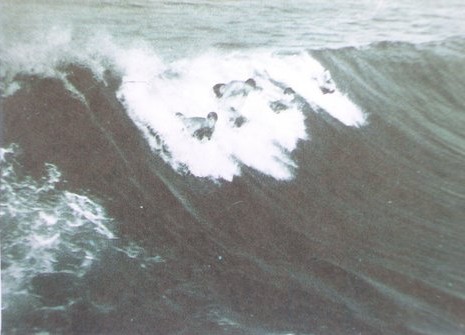
Photo likely by Fred Hamilton,
courtesy of Derek Jardine.
4. Did the tourist boards have nose lift in them? What
sort of shops sold
them?
The
"tourist board" had very little lift in
them and were sold by the
local grocer or general dealer. There were no shops like we have them
today. The boards pictured below are examples of typical South Africa
belly boards with nose lift of varying degree, not the tourist boards.
The oak board
on the left
was made by David George Phillips in 1930, and used around South Beach,
Durban. This and the other boards are part of the late Baron Stander's
collection.
|
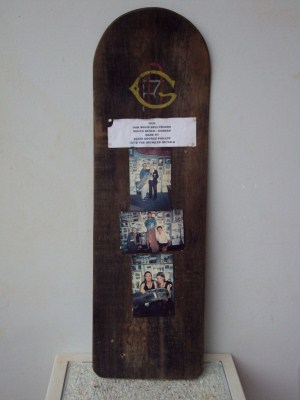
|
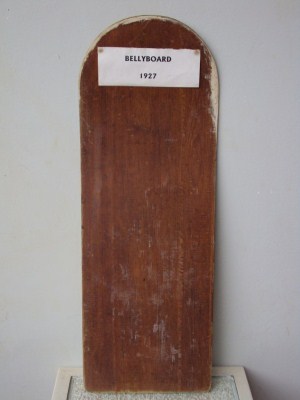
|
Photos courtesy of Surfing
Heritage South Africa.
|
The nail holes
on the
tail suggest a protective strip covered the tail. The 1927 oak board on
the right was purchased at Muizenberg Beach [see Note
2]
by Lady Hoight, wife of Sir Louis Hoight
the Provincial Governor for 17 shillings and six-pence.
|
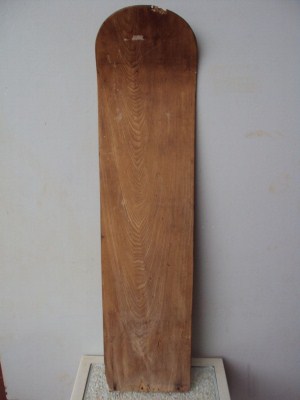
|
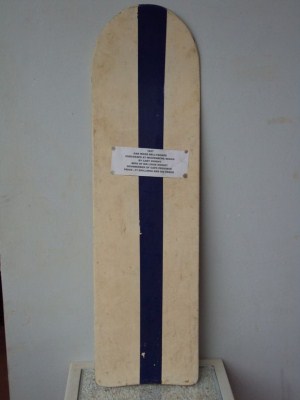
|
Photos courtesy of Surfing
Heritage South Africa. |
5. So were
the paipo boards you were riding like the ones pictured in the above
photos?
The boards were very similar to the photos, but
we modified them to our
own needs. I notice a Surfoplane in one of your pictures!
Bellyboards,
handplanes and a surf mat in the late Baron Stander's Durban Timewarp
Surf Museum, 1999. This photo gives an indication of the respective
size of the boards featured elsewhere in this interview.
|
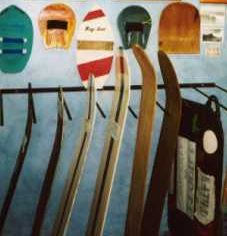
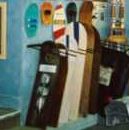
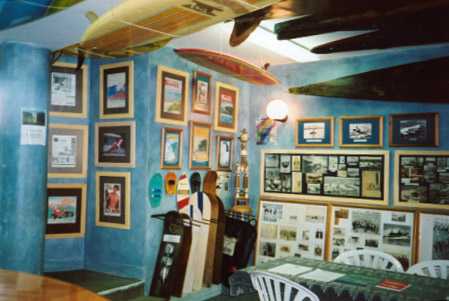
|
Photos courtesy of Harry Bold. |
6. What were your boards like?
We would cut off the end of the board to about
two and a half feet to 3
feet, bend the rocker up a bit more and we had a good ridable
bodyboard, which we could jump off the end of the pier with and catch
some pretty big waves. Mainly we could swim with them with an overarm
movement.
How did you bend the
rocker in the boards?
First we used to cut off a portion of the board to
the size we wanted
it, then heat the nose by way of boiling a kettle and then holding the
steam under the nose, and bending it. Very primitive but it worked!!
7. You
mentioned the boards were cut down so you could
swim with them. What did you mean by this? How did you swim with them?
If
you didn't lie on the boards there must have been a lot of cross-over
with bodysurfing technique?
Yes, we cut them down to about +/- 22 to 24 inches so
that we could
swim overarm with them. Remember swimming in the surf is very different
to swimming in a pool. By swimming I mean we had to swim out to the
back line, mostly in pretty big and rough surf in order to catch the
waves. Mostly we tried to dive off the end of the pier but if the
surf was breaking at another spot other than next to the pier we had to
get to the back line which sometimes was about 200 to 250 yards
offshore, and a lot of times we had problems with the fishermen on the
pier. They hated those kids messing with their fishing!
The boards were
too short to lie on and paddle, it really was a different type of
surfing, but probably similar to the Hawaiian's paipo boards, but more
primitive. We could swim into the swell and use the board to break the
wave and we were away and riding all the way to shore! The bigger guys
obviously had slightly bigger boards as we used to measure the length
by measuring from under the armpit to the tip of our fingers. We
actually called them "Dumper Boards."
8. How did you surf the
boards?
We could not lie on the boards as they were too
short, but held the
nose of the board and steered across the wave.
9. What sort of waves were these boards best suited to?
The best waves were with an offshore or
westerly wind, but they worked
quite well with a big easterly (onshore) swell.
10. Did you use flippers?
No, we never used flippers in those days. I
don't think they were
invented yet! As kids we were on the beach just about every day, so we
had to have something to do.
11. Did you keep riding the ply boards?
Next came the Surfoplanes from Australia, which
was also a lot of fun
on the bigger waves. Then came the long wooden surfboards, so as we got
older we gave up the
old type body boards and surfed longboards. There are some pretty good
fancy bodyboards and kneeboards being ridden here today.
South
Durban
surfing: (below left) Shorty Bronkhorst (far left), Leith Jardine and
Noel Dodd; (below right) Leith Jardine, Derek's younger brother.
|
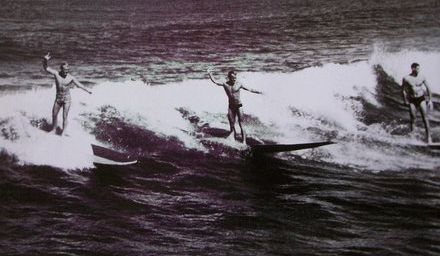
|
|
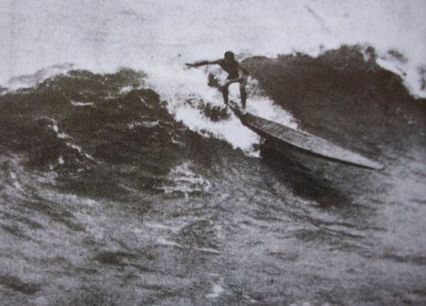
|
Photos courtesy of Derek Jardine. |
12. Where did you surf the longboards? Are you still
surfing?
The
longboards came once we were able to carry them!! And then we
started making our own wooden hollow boards, with a bunghole to let the
water out,
about +/- 12 ft.
Then in about 1952, I think, the Australian Lifesaving Team came to
Durban to compete against our South Africa Team,and I bought one of the
Aussie
boards. (I can
send you some pics if you like!! I think the board was about 16 ft
long!) In 1955, I moved to Cape Town, and brought that same board with
me. I can remember surfing Muizenberg on a good day and being the only
boardrider in the water! Not many surfers in Cape Town in the 1950s
that I saw. A few years later, I sold the board to a local guy and
imported a Hansen board from the USA. Surfed the longboards from then
on in Cape Town. Was surfing up to three years ago when I visited
California to visit my son who is a pretty good surfer. I was the
78-years-old then! Now, I just swim. So keep surfing, as old surfers
never
die, they just fade away until the take their last
swim!!!
(Below left)
Derek and Neil
Von Coller with home made boards, Durban, ca. 1948. The decals were
painted on by an older local surfer.
(Below right) South Beach Durban, ca. 1949. Six
boys and a girl on the crest of a wave.
|
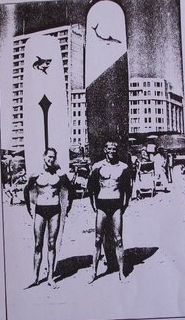
|
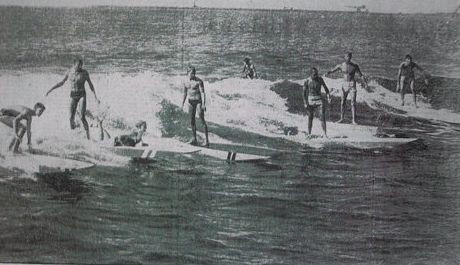
Pictured above are Ronnie
Walker, Bruce Giles
and
Wendy Hall, Derek Jardine. Anthony Heard, Wyndon Woodford, and Pierre
Cerf,
"taking a slide, to provide for a pleasant holiday on South Beach
yesterday." Derek writes that Anthony and Pierre are still around.
Geoff Cater advised that the "flat deck with a deep
rockered bottom" was "substantially different to the Australian Racing
16" (personal e-mail to
Bob Green, January 29, 2013).
|
Photos courtesy of Derek Jardine. |
|
Crocker
skis and longboards were also popular waveriding craft of the era.
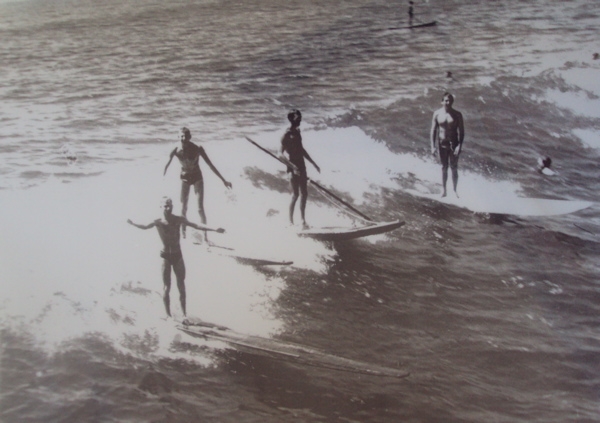
Photo
courtesy of Johnny Vassilaros
and Allan Jackson.
Note 1: The
surfoplane was the forerunner of the modern surf mat. Learn more about
the surfoplane in our Paipo
Interview with the John Ruffels, the inventor of the surfoplane.
Note 2:
Surfing at Muizenberg has a long
history, documented on
postcards, jig-saws, travel brochures and books such as Lord Frederick
Spencer's
Here, There and Everywhere, "You walk out in the shoal water up
to your shoulders, and as a big sea comes in, you throw yourself chest
foremost on to your plank, and are then carried along on the top of the
roller at the pace of a leisurely train (an Isle of Wight train), to be
deposited with a bang on the sandy beach. It is really capital fun...".
(See pages 267-268 in Hamilton, Lord Frederic. (1921). Here, there
and everywhere. New York: George H. Doran company. See download
here.)
(Below left)
George Bernard
Shaw at Muizenberg. (Below right) Muizenberg postcard shows kids and
adults riding bellyboarding planks, ca.
1929.
|
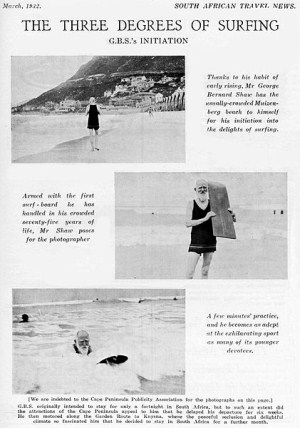
|
|
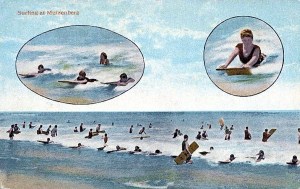
|
(Left)
Unknown author. (1932,
March). The Three
Degrees of Surfing. South
African
Travel News. Both items are
courtesy of Hilton Teper of the UK
(formerly of Cape Town, South Africa). More at
MyPaipoBoards.org on George Bernard
Shaw and paipo
postcards.
The
Cape Peninsula Publicity Association promoted the sport of surfing
(bellyboarding) in their annual publications. Shown below are covers
from their 1918 and 1923 editions, left and right, respectively.
|
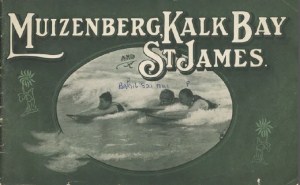
|
|
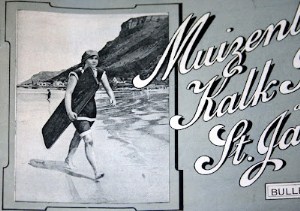
|
The 1918 edition describes the infectiousness of surf bathing at Muizenberg,
"The great
essential for "surfing" as the sport is termed, is a smooth plank a
couple of feet wide and about four feet in length. Armed with this the
devotee wades far out where the waves are breaking best. He then waits
his opportunity. A fine big curling breaker comes rushing in. The
surfer throws himself on the plank, is caught by the wave and whirled,
straight as a die, for the beach. The wave tries to overtake him, but
itself is his propelling power, and he is always just ahead until in
the shallows it is spent and hisses harmlessly by."
|
(Left)
Cape Peninsula Publicity Association. (1918). Muizenberg, Kalk Bay
and St. James. Cape Town: Cape Peninsula Publicity
Association. Courtesy of Bev Angus,
African Studies Library, University of Cape Town.
(Right) Cape Peninsula
Publicity Association. (1923). Muizenberg, Kalk Bay and St. James.
Cape Town: Cape Peninsula Publicity Association. Courtesy of the
Surfing Heritage Foundation, via Wingnut from an acquaintance of
his.
Michael Walker
has also documented the history of surfing in several self-published
books. Shown below are Muizenberg - A forgotten Story (2009)
and The
Golden Years: A postcard
memoir of the Kalk Bay-Muizenberg municipality 1895-1996 (revised
edition 1997).
|
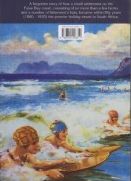
|
|
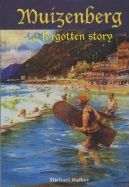
|
Courtesy
of
Bev Angus, African Studies Library, University of Cape Town. The cover
features the 1924 painting by G. Turner "First Pavilion and surfers." |
Back
and front covers of Muizenberg: the golden years.
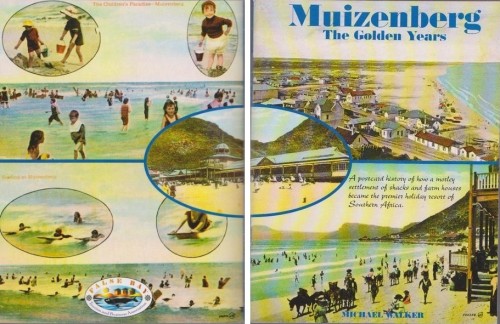
Courtesy
of Rod Rodgers.
Walker's books include:
Walker, Michael. 1997. The golden
years: a postcard memoir of the
Kalk Bay- Muizenberg municipality, 1895-1913. Cape Town: M. Walker.
Walker, Michael. 1999. Coastal memories: Muizenberg,
St. James, Kalk Bay, 1870-1920. [St. James, Cape Town]: M. Walker.
Walker,
Michael. 2004. Muizenberg: the golden years. St. James: M.J.
Walker.
Walker, Michael. 2004. Kalk Bay, St. James: a brief history
illustrated with postcards of a bygone era. St. James [South
Africa]: M.J. Walker.
Walker, Michael. 2009. Muizenberg - a forgotten story. St.
James [South Africa]: M. Walker.
|
|
